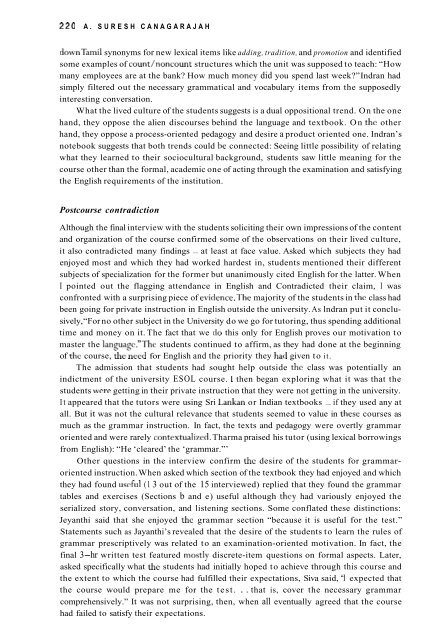English Language Teaching in its Social Context
English Language Teaching in its Social Context
English Language Teaching in its Social Context
Create successful ePaper yourself
Turn your PDF publications into a flip-book with our unique Google optimized e-Paper software.
220 A. SURESH CANAGARAJAHdownTamil synonyms for new lexical items like add<strong>in</strong>g, tradition, and promotion and identifiedsome examples of count/noncount structures which the unit was supposed to teach: “Howmany employees are at the bank? How much money did you spend last week?” Indran hadsimply filtered out the necessary grammatical and vocabulary items from the supposedly<strong>in</strong>terest<strong>in</strong>g conversation.What the lived culture of the students suggests is a dual oppositional trend. On the onehand, they oppose the alien discourses beh<strong>in</strong>d the language and textbook. On the otherhand, they oppose a process-oriented pedagogy and desire a product oriented one. Indran’snotebook suggests that both trends could be connected: See<strong>in</strong>g little possibility of relat<strong>in</strong>gwhat they learned to their sociocultural background, students saw little mean<strong>in</strong>g for thecourse other than the formal, academic one of act<strong>in</strong>g through the exam<strong>in</strong>ation and satisfy<strong>in</strong>gthe <strong>English</strong> requirements of the <strong>in</strong>stitution.Postcourse contradictionAlthough the f<strong>in</strong>al <strong>in</strong>terview with the students solicit<strong>in</strong>g their own impressions of the contentand organization of the course confirmed some of the observations on their lived culture,it also contradicted many f<strong>in</strong>d<strong>in</strong>gs - at least at face value. Asked which subjects they hadenjoyed most and which they had worked hardest <strong>in</strong>, students mentioned their differentsubjects of specialization for the former but unanimously cited <strong>English</strong> for the latter. WhenI po<strong>in</strong>ted out the flagg<strong>in</strong>g attendance <strong>in</strong> <strong>English</strong> and Contradicted their claim, I wasconfronted with a surpris<strong>in</strong>g piece of evidence.The majority of the students <strong>in</strong> the class hadbeen go<strong>in</strong>g for private <strong>in</strong>struction <strong>in</strong> <strong>English</strong> outside the university. As lndran put it conclusively,“For no other subject <strong>in</strong> the University do we go for tutor<strong>in</strong>g, thus spend<strong>in</strong>g additionaltime and money on it. The fact that we do this only for <strong>English</strong> proves our motivation tomaster the languagc.”The students cont<strong>in</strong>ued to affirm, as they had done at the beg<strong>in</strong>n<strong>in</strong>gof the course, thc nced for <strong>English</strong> and the priority they had given to it.The admission that students had sought help outside the class was potentially an<strong>in</strong>dictment of the university ESOL course. 1 then began explor<strong>in</strong>g what it was that thestudents were gett<strong>in</strong>g <strong>in</strong> their private <strong>in</strong>struction that they were not gett<strong>in</strong>g <strong>in</strong> the university.It appeared that the tutors were us<strong>in</strong>g Sri Lankan or Indian textbooks - if they used any atall. But it was not the cultural relevance that students seemed to value <strong>in</strong> thec;e courses asmuch as the grammar <strong>in</strong>struction. In fact, the texts and pedagogy were overtly grammaroriented and were rarely contextuali7ed. Tharma praised his tutor (us<strong>in</strong>g lexical borrow<strong>in</strong>gsfrom <strong>English</strong>): “He ‘cleared’ the ‘grammar.”’Other questions <strong>in</strong> the <strong>in</strong>terview confirm the desire of the students for grammaroriented<strong>in</strong>struction. When asked which section of the textbook they had enjoyed and whichthey had found useful (1 3 out of the 15 <strong>in</strong>terviewed) replied that they found the grammartables and exercises (Sections b and e) useful although they had variously enjoyed theserialized story, conversation, and listen<strong>in</strong>g sections. Some conflated these dist<strong>in</strong>ctions:Jeyanthi said that she enjoyed the grammar section “because it is useful for the test.”Statements such as Jayanthi’s revealed that the desire of the students to learn the rules ofgrammar prescriptively was related to an exam<strong>in</strong>ation-oriented motivation. In fact, thef<strong>in</strong>al 3-hr written test featured mody discrete-item questions on formal aspects. Later,asked specifically what the students had <strong>in</strong>itially hoped to achieve through this course andthe extent to which the course had fulfilled their expectations, Siva said, ‘‘I expected thatthe course would prepare me for the test. . . that is, cover the necessary grammarcomprehensively.” It was not surpris<strong>in</strong>g, then, when all eventually agreed that the coursehad failed to satisfy their expectations.












